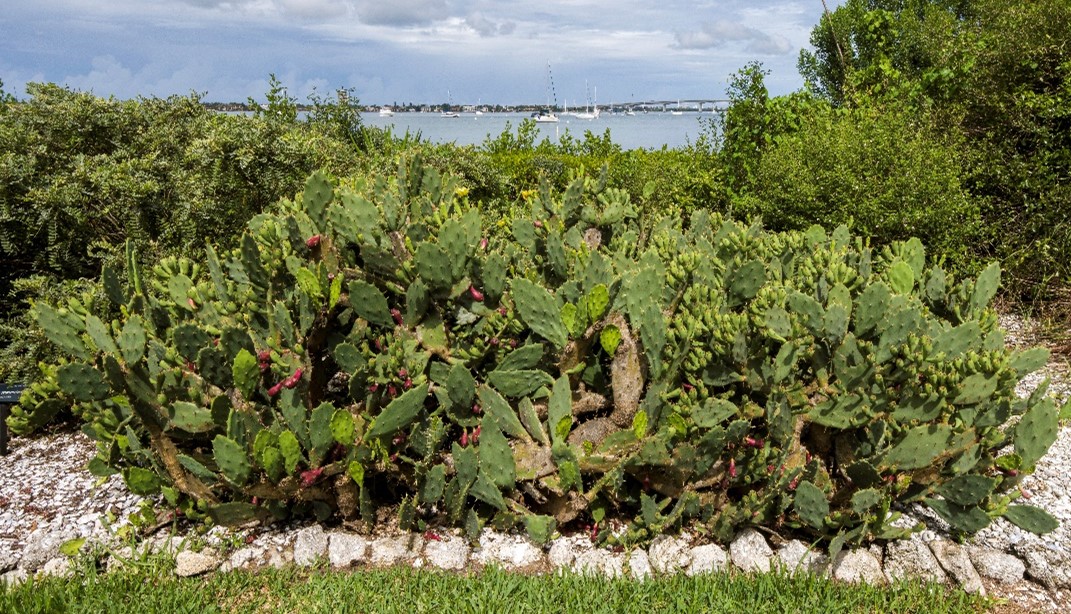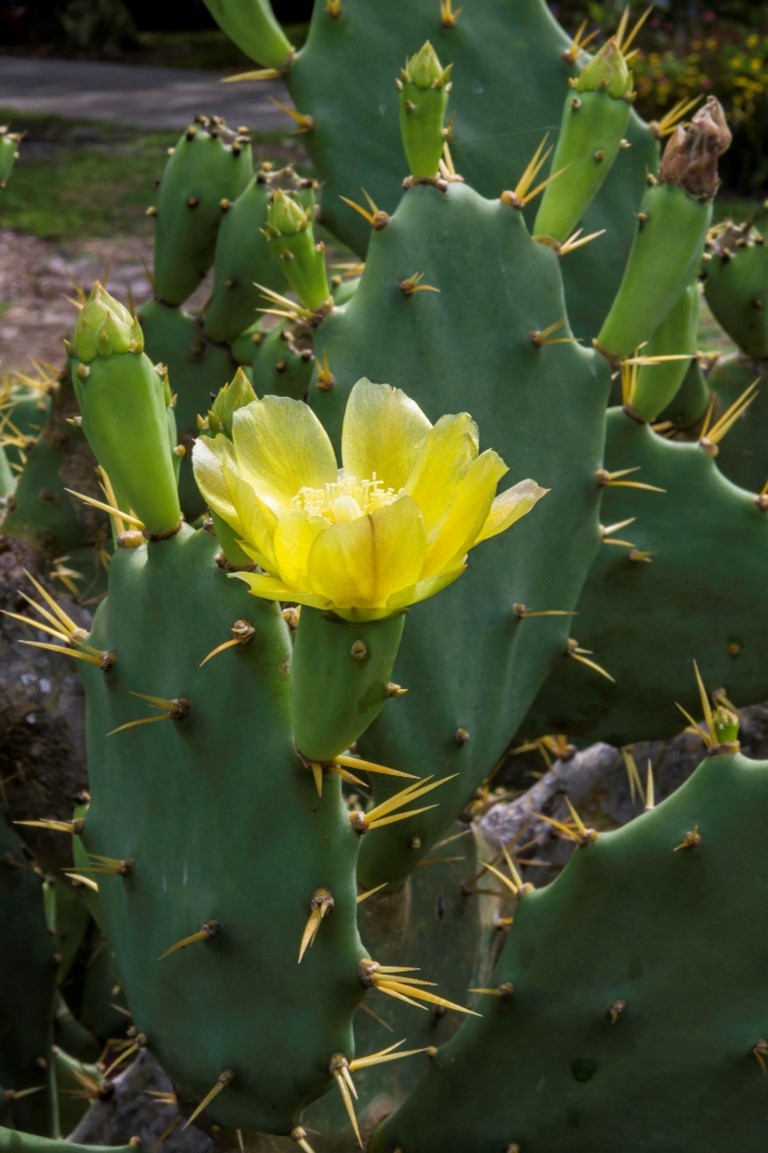By Shawn McCourt, plant records keeper
Erect or shell mound prickly pear (Opuntia stricta) is a cactus species native to the Gulf and Atlantic coasts of Florida and other southeastern states, where it grows in well-drained sand or shell on coastal ridges, dunes, grasslands, and hammocks near the sea. As the common name suggests, it also has a strong affinity for the vast shell mounds constructed by Florida’s early peoples. It shares this association with shell mounds in common with other native (and non-native) tropical and subtropical xerophytic species, including the federally endangered, endemic prickly apple cacti (Harrisia aboriginum, H. fragrans). Examples of these xerophytic plant communities can be seen on the shell mounds and coastal ridges at our Historic Spanish Point campus.

Large clonal group of O. stricta planted on artificial shell mound west of the Events Center at Selby Gardens’ Downtown Sarasota campus (Photo by Aaron Fink).

Opuntia stricta in flower now at Selby Gardens’ Downtown Sarasota campus (Photo by Aaron Fink).
Two forms of Opuntia stricta are recognized in Florida: O. stricta var. dillenii, which has more rounded stems with 0-11 generally curved, spreading dark yellow spines, strongly flattened at the base and often dark brown to black at the lower half; and O. stricta var. stricta which has flatter stems with 0-3 generally straight, erect yellow spines, round or slightly flattened at the base (Majure 2015). Other differences include oval or spatulate stems with straight margins and perpendicular spines in var. stricta and obovate or rhomboid stems with wavy margins and slightly or noticeably curved spines in var. dillenii.
Regardless of the variety, shell mound prickly pear is a long-lived plant that can form extensive clonal colonies, since any of the cladodes (flattened stems or pads) separated from the main plant are capable of rooting and growing into a new, identical plant. The showy, bright yellow flowers can appear any time of year, but tend to be most profuse from May to July, and they are pollinated by insects, including bees, ants, and hoverflies. The flowers are followed by thick, 2–4 inch green fruits that ripen to a deep red or purple before they are eaten by wildlife. Mammals, birds, and some reptiles, including the threatened Gopher Tortoise (Gopherus polyphemus), all consume the fruits and disperse the seeds, which may remain viable in the soil for as long as 10 years before germinating when conditions are ideal. The ripe fruits, called tunas, are also relished by people, either fresh, dried, or canned. They can be made into jellies, juices, and shakes and may have considerable health benefits.
This useful and highly ornamental plant has been introduced to many other parts of the world where, freed of its natural constraints, it has become an invasive pest in some areas. In subtropical parts of India, Africa, and Australia, it was widely planted as hedging to fence in livestock before the invention of barbed wire. In these places, it escaped cultivation and became an aggressive competitor in more sensitive natural plant communities. The cactus is considered Australia’s oldest and most noxious weed, having arrived there on the first fleet, and effectively invading nearly 24 million hectares (59.3 million acres) of land in Queensland and New South Wales before it was brought under control. This control came in 1926, with the release of the Argentine cactus moth (Cactoblastis cactorum) as a biocontrol agent. The moth’s larvae tunnel into, and feed on, the cactus stems, hollowing them out and killing them in the process. The release of the moth was so effective that the cactus had all but disappeared from Australia within the span of a decade. Today, it is limited to remnant infestations in places where the moth is less effective, possibly because of predation of its larvae by ants. The same moth was introduced as a biocontrol agent on some Caribbean islands, however, it has since spread from the Caribbean to Florida, where it has decimated our native populations of prickly pears, including O. stricta. As a result, erect prickly pear is now considered a threatened species in Florida. In South Florida, it has also hampered efforts to conserve some of our most endangered prickly pear species, including the Florida Keys endemic semaphore cactus, Consolea corallicola. As the moth extends its range northwards and westwards at an estimated rate of a 100 miles per year, the rich diversity of prickly pears in Texas, Mexico and the American Southwest are facing potentially large-scale losses that will pose enormous ecological as well as social and economic impacts in these areas. Fortunately, research is being carried out at the University of Florida on the potential introduction of a parasitoid wasp that keeps the moth under control in its native Argentina. If completed in time, the research could potentially slow or reverse the moth’s impact on our native prickly pears.
Further Reading:
Atlas of Florida Plants – Opuntia stricta
CABI – Invasive Species Compendium – Opuntia stricta (erect prickly pear)
CABI – Invasive Species Compendium – Cactoblastis cactorum (cactus moth)
https://en.wikipedia.org/wiki/Cactoblastis_cactorum
Additional References:
Majure, Lucas. In: Weakley, A.S. 2015. Flora of the Southern and Mid-Atlantic States. 21 May 2015. University of North Carolina at Chapel Hill
